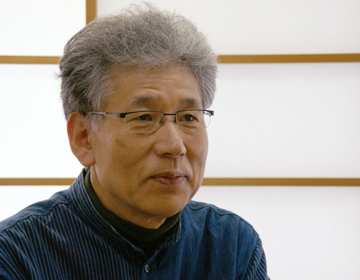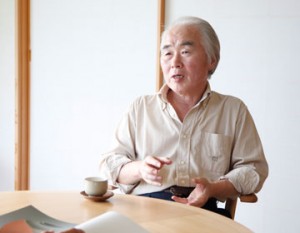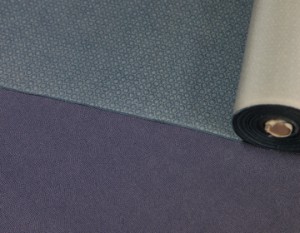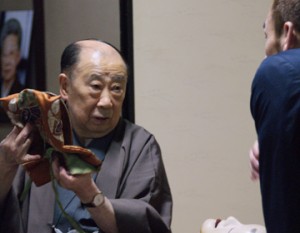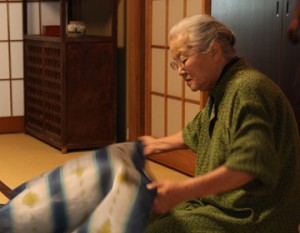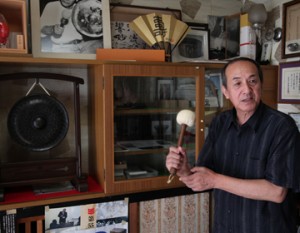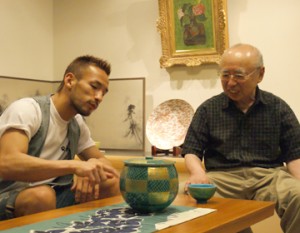“Adjusting to Show Just Enough”
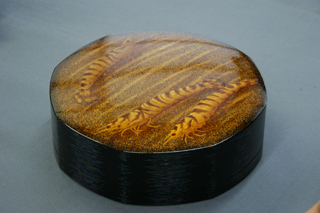
We spoke with Kazumi Murose, a holder of Important Intangible Cultural Asset of lacquer craft in the field of ”makie”. Murose specializes in the technique, ”kenshutsu makie”. It is the skill of drawing a motif on a lacquer-laid foundation with silver and gold powder or dried colored lacquer powder, before it becomes dry. After the lacquer solidifies, another coat of lacquer is applied and allowed to harden, which is then sanded down and polished so that the motif buried underneath appears on the surface. In order to produce the desired effect, you must know exactly how much of the multiple layers of gold and lacquer should be shaved. Murose creates a 3 dimensional effect through this process.
We studied a box with a picture of a swimming prawn, using the makie technique. It was a vivid, life-like 3 dimensional picture, with different tints; strong gold, shown with a large amount of gold powder, and dark amber from the lacquer which showed less gold. Nakata seemed completely drawn in by its profound colors, and commented, ”Both the colors of the gold and the lacquer are beautiful.” Murose explained, ”Many of the older ”makie” pieces are flat with a one-dimensional look. The 3 dimensional effects are the modern style of ”makie”.”
The breadth of Japanese expression
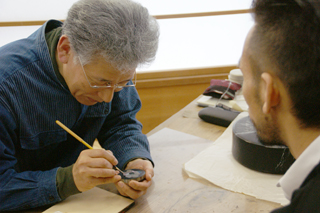
Nakata explained the mission of his journey, ”There are so many people in Japan that work in the field of art or that are involved in ”kogei”. So I end up having to visit many people.” Murose replied, ”That is the strongest feature of our country, Japan.”
”Take one field, lacquer for instance. Japan has a wide genre, from lacquer for daily use to lacquer as artistic objects. Either purpose requires delicate skill. That is why so many interesting objects are created. Some are used for daily use while others are works of art, dedicated to shrines. Unless there is a variety, you cannot express all the undulating emotions of humans.”
Murose also does research work regarding old techniques, and helps to restore cultural property. There are many discoveries during the restoration process, where techniques not known in modern times are discovered. He told us that he started his research for cultural properties by recommendation from one of his teachers.
”He told me to restore them for the people from 300 or 400 years ago, as they are probably disappointed. Those words enlightened me, because I imagined how I would want my work to be restored if any of them were damaged. I would also feel disappointed if they weren’t. I now understand what he meant.”
Learning about the skills and thinking about the feelings of people of the past through older works. Based on this experience, new ”makie” expressions are sought with modern style. That is how Murose’s works of art are created.
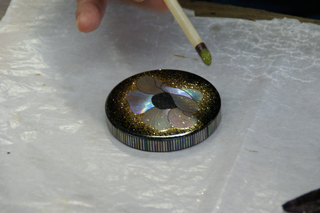
Eating from a Lacquered Bowl
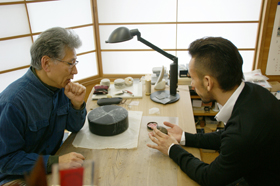
Murose asked us, ”You know the word, ”wan” don’t you?”
”Wan” as in ”茶碗 chawan” or bowl?”
”Yes, when you write the word ”茶碗 chawan” you use the Chinese character stone on the left, because it is ceramic. You pour hot tea in it, and it cools quickly, thus ceramics is the best fit.”
”Oh, now I get it. When you use the word ”椀 wan ” for rice, the character on the left is wood!”
”Yes, that’s right. We used to eat rice from a wooden bowl. Wooden bowls were adequate as the rice didn’t cool and if the bowl was lacquered, it prevented it from getting damp. You don’t have to eat rice in a rush because the wood keeps it warm and tasty.”
While we tend to eat rice using ceramic bowls, wooden bowls are actually a better choice.
”I want you to give it a try. Eat rice from a wooden bowl, a lacquered one. It will keep the rice nice and warm, and it will allow you to enjoy meal time conversations.” Murose told us. This had never come to mind even though it makes sense considering the materials and their features. Cultural history never ceases to amaze.



